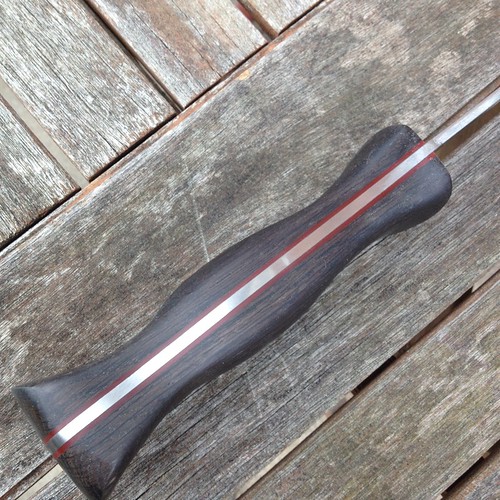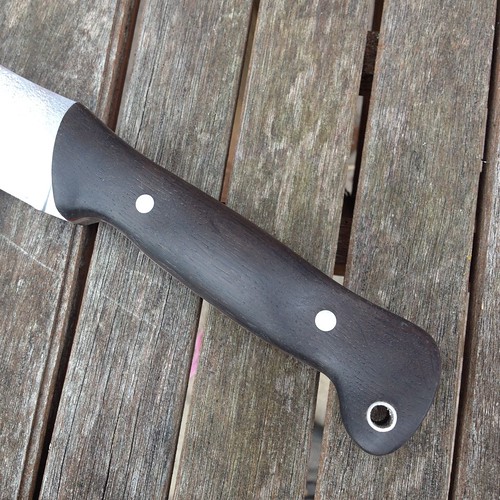Hi All,
I have a Khukuri that was given to me as a gift by a friend returning from Nepal. It came in KHHI wrapping so in theory a decent working model. The handle is a full tang affair with hardwood scales, pinned by two largish rivets.
The first time I used it to do some very lightchopping, the scales slipped upwards by a couple of mm. I peened the rivets a little which helped but put it away for when i had time to sort things out more permanently.
Having found some time I was about to ask advice about removing the scales and refiiting so took some pictures. whilst doing that I noticed what appears to be a worrying flaw in the tang at the point the bolster is fitted, on the bottom edge behind the cho. At first I thought it was just a nick from a file but on closer inspection it seems like a section of the tang is actually skewed out of line and may be cracked but it has clearly been filed and blended into the bolster in that position.
This is the only Khuk I have handled but if I saw this kind of thing in any of my billhooks I would be worried.
Just looking for thoughts from more experienced knife makers / khuk owners really. Salvageable or destined to be a 'conversation piece'?
Obviously as a gift it has value to me either way.
Thanks for looking.

I have a Khukuri that was given to me as a gift by a friend returning from Nepal. It came in KHHI wrapping so in theory a decent working model. The handle is a full tang affair with hardwood scales, pinned by two largish rivets.
The first time I used it to do some very lightchopping, the scales slipped upwards by a couple of mm. I peened the rivets a little which helped but put it away for when i had time to sort things out more permanently.
Having found some time I was about to ask advice about removing the scales and refiiting so took some pictures. whilst doing that I noticed what appears to be a worrying flaw in the tang at the point the bolster is fitted, on the bottom edge behind the cho. At first I thought it was just a nick from a file but on closer inspection it seems like a section of the tang is actually skewed out of line and may be cracked but it has clearly been filed and blended into the bolster in that position.
This is the only Khuk I have handled but if I saw this kind of thing in any of my billhooks I would be worried.
Just looking for thoughts from more experienced knife makers / khuk owners really. Salvageable or destined to be a 'conversation piece'?
Obviously as a gift it has value to me either way.
Thanks for looking.






